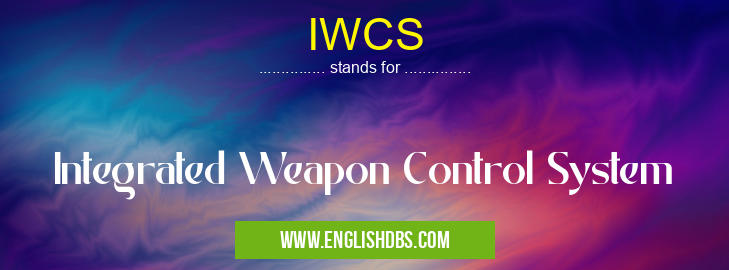What does IWCS mean in MILITARY
Integrated Weapon Control System (IWCS) is a crucial component of modern naval warfare, designed to enhance the effectiveness and efficiency of shipboard combat operations. It integrates various weapon systems, sensors, and command and control elements into a single, cohesive platform.

IWCS meaning in Military in Governmental
IWCS mostly used in an acronym Military in Category Governmental that means Integrated Weapon Control System
Shorthand: IWCS,
Full Form: Integrated Weapon Control System
For more information of "Integrated Weapon Control System", see the section below.
» Governmental » Military
Components of IWCS
- Sensors: IWCS incorporates a wide range of sensors, such as radars, sonars, and electronic warfare systems, to provide comprehensive situational awareness.
- Weapon Systems: It controls and coordinates the operation of various weapon systems, including missiles, guns, and torpedoes.
- Command and Control: IWCS provides a central interface for commanding officers to make tactical decisions and control the ship's weaponry.
Benefits of IWCS
- Enhanced Situational Awareness: IWCS provides a real-time, integrated view of the battlespace, enabling quick and informed decision-making.
- Improved Weapon Effectiveness: It optimizes weapon targeting and coordination, enhancing the accuracy and lethality of shipboard armaments.
- Increased Survivability: IWCS helps protect the ship by integrating defensive systems and providing early warning of incoming threats.
- Reduced Crew Workload: Automation and integration streamline tasks, reducing the workload on shipboard personnel.
- Enhanced Interoperability: IWCS facilitates communication and data sharing between ships, allowing for coordinated operations in complex maritime environments.
Essential Questions and Answers on Integrated Weapon Control System in "GOVERNMENTAL»MILITARY"
What is an Integrated Weapon Control System (IWCS)?
An Integrated Weapon Control System (IWCS) is a centralized system that manages and controls all aspects of a weapon system, including sensors, weapons, and fire control. It provides a single, integrated interface for the operator, allowing them to control the system with greater efficiency and accuracy.
What are the advantages of using an IWCS?
IWCS offers several advantages, including:
- Improved situational awareness for the operator
- Increased accuracy and effectiveness of weapons
- Reduced operator workload
- Enhanced survivability of the system
What are the key components of an IWCS?
Key components of an IWCS typically include:
- Sensors: Collect data on the target environment
- Weapons: Engage targets with various types of munitions
- Fire control: Calculates and adjusts firing solutions
- Operator interface: Provides a graphical user interface (GUI) for operator control
How does an IWCS differ from a traditional weapon control system?
Traditional weapon control systems are typically decentralized and may require multiple operators to control different aspects of the system. In contrast, an IWCS is centralized and provides a single interface for the operator, simplifying operation and improving efficiency.
What are some examples of platforms that use IWCS?
IWCSs are used in a variety of platforms, including:
- Naval vessels
- Aircraft
- Ground vehicles
Final Words: The Integrated Weapon Control System plays a vital role in modern naval warfare, providing a comprehensive and integrated platform for controlling and coordinating shipboard combat operations. Its advanced capabilities enhance situational awareness, weapon effectiveness, survivability, and overall operational efficiency.
